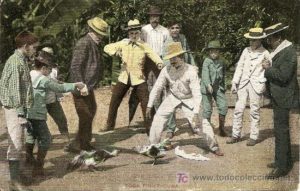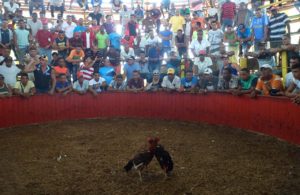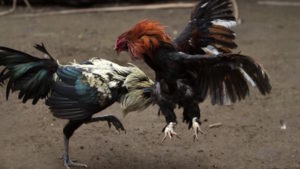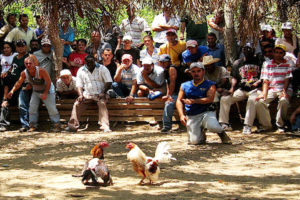The Fight or a cockfight is a fight that takes place between two roosters of the same genus or race of birds called “fine fighting birds”, encouraged by humans for their enjoyment.
The oldest known cockfight was in China, going through India and later it was taken to America by the Spanish conquerors.
The arena, arena, palenque or coliseum, which is destined for that specific purpose, is known as “Gallera”, where the bird that shows the best qualities in combat is declared as the winner. For this you must leave your adversary disabled to continue fighting. In some cases there are roosters with “little caste” fleeing the fight when they are injured in which case they lose the fight or the fight. In most cases fine image or combat miniatures are created under rules of vaccination, feeding and special care to achieve an ideal physical development and those with the best qualities for the fight undergo a physical conditioning or training to arrive to meet him in the arena, court, coliseum, etc.
In some regions, in the fights, the roosters are equipped with artificial spurs of plastic, hawksbill, fish bone, steel, etc. that allow birds to hurt their opponent more easily than with their natural spurs. In other variations of fighting the natural spurs are covered with a cloth or leather covering to prolong the fight. The fight without artificial spurs or without wrapping them is called a “bare heel” fight. Another form of weapon in the cockfight is the use of knives on the legs of the animal with varying sizes and shapes (from 1/4 inch to 4 inches), thus supplanting your natural fighting weapon. This is practiced in Guatemala, the United States, Mexico, Nicaragua, Honduras, Panama, Peru, the Dominican Republic, the Philippines and Puerto Rico.
In Cuba it is customary to fit the fighting cocks with natural false spurs. The obtaining of these natural spurs presupposes the parallel upbringing of roosters with this sole purpose, whose spurs are subjected to a very careful and prolonged treatment until they reach the dimensions required for their extraction and processing. In the rest of America this activity is carried out with natural or artificial spurs.
Cockfighting is legal in most Latin American countries, as well as in three European regions Canary Islands, Andalusia, and the French region of North-Pas de Calais, and in Asian countries such as the Philippines. In many other places, animal fights are prohibited, based on opposition to betting, animal cruelty, or both.
The history of cockfighting in Cuba.
The first official document known about cockfighting in Cuba dates from April 8, 1737 and consists of a royal decree asking the governor for a report on whether cockfighting could have “problems with the people of the sea and the land “and news about the lease of the game is requested. This game became so common in the colonial era that “fences” were built in all the urban or rural towns, which is how the rings created for this purpose are known in Cuba. In Havana, in the center of the city, between the Castillo de la Fuerza and the Intendencia building, Don Francisco Dionisio Vives, then Captain General of Cuba had a gallery for his amusement and that of his friends. In Cuba, between 1844 and 1844, the Decree of July 25, 1844 was issued, prohibiting the fight of roosters in villages and the assistance to the fences of people of color and “children of families”. Access to people of color was forbidden, because in the fences, with the passion of the fight social differences were forgotten, without recognizing in that show any line that marked caste differences. In addition, these activities were meeting points to conspire against the Spanish government. During most of the second half of the 19th century, authorizations were granted to establish billboards for roosters. In 1899 the then Civil Governor of Havana, General Juan Rius Rivera, banned cockfighting by the Decree of October 31, 1899. And on April 19, 1900, the Governor of Cuba, General Leonard Wood, at the proposal of his Secretary of the Interior and State, Dr. Diego Tamayo, issued military order No.165 prohibiting cockfighting since June 1, 1900 in the entire territory of the island. In 1909, the then President of the Republic of Cuba, José Miguel Gómez, to win supporters again authorized cockfighting and regulations were agreed upon for their execution. In the first half of the twentieth century the legality of cockfighting in Cuba suffered several ups and downs. https://youtu.be/hZirkyYr8bk Until the end of 1967 and the beginning of 1968 fights took place all over the country, but in order to eliminate the bets the fences were closed and the fights were forbidden, although not the raising of the roosters. But in 1980 the authorities decriminalized the fights eliminating them as criminal figures and turning them into simple contraventions. From then on, a state plan was developed as a business organization represented by the National Flora and Fauna Company, attached to the Ministry of Agriculture, whose organization has breeding, care and collection centers for fighting cocks and groups all Private breeders with representation in all the provinces grouped by territories. The organization programs several fairs or provincial and national tournaments a year in the months of January-April with the aim of testing the offspring and the quality of the roosters, but without mediating monetary interest in the results of the fights. The business organization maintains commercial relationships selling roosters to breeders from other Caribbean countries, where cockfighting is common. But only the Cuban government controls everything related to sale, production, etc … even though the people do not always follow the guidelines and the cock fights are still carried out semi-clandestine by the peasants and fans of the cockfights that they do not let anyone get in the way of their private tastes. LAS PELEAS DE GALLOS Y SU HISTORIA EN CUBA. Una pelea de gallos o riña de gallos es un combate que se lleva a cabo entre dos gallos de un mismo género o raza de aves denominada “aves finas de combate”, propiciados por el ser humano para su disfrute. La mas antigua pelea de gallos conocida fue en China, pasando por la India y posteriormente fue llevada a América por los conquistadores españoles. La arena, ruedo, redondel, palenque o coliseo, que es destinado para ese fin específico se conoce como “Gallera”, donde el ave que demuestra mejores cualidades en el combate se declara como ganadora. Para ello debe dejar a su adversario inhabilitado para seguir peleando. En algunos casos hay gallos con “poca casta” que huyen de la pelea al estar heridos en cuyo caso pierden el combate o la pelea. En la mayoría de los casos se realizan miniatura de imagen finas o de combate son criados bajo normas de vacunación, alimentación y cuidados especiales para lograr un desarrollo físico ideal y los de mejores cualidades para la riña se someten a un acondicionamiento físico o entrenamiento para llegar a su encuentro en el ruedo, cancha, coliseo, etc. En algunas regiones, en las riñas, los gallos son equipadas con espolones artificiales de plástico, carey, hueso de pescado, acero, etc. que permiten que las aves puedan herir a su oponente más fácilmente que con sus espolones naturales. En otras variaciones de riña los espolones naturales son cubiertos con una envoltura de tela o cuero para prolongar el combate. La riña sin espolones artificiales o sin envoltura en los mismos se le denomina como pelea a “talón desnudo”. Otra modalidad de arma en la riña de gallos es la utilización de navajas en las patas del animal con medidas y formas variables (desde 1/4 pulgada hasta 4 pulgadas), suplantando de este modo a su arma natural de pelea. Esto se practica en Guatemala, Estados Unidos, México, Nicaragua, Honduras, Panamá, Perú, República Dominicana, Filipinas y Puerto Rico. En Cuba se acostumbra calzar los gallos de pelea con espuelas naturales postizas. La obtención de estas espuelas naturales presupone la crianza paralela de gallos con este único fin, cuyas espuelas son sometidas a un tratamiento muy cuidadoso y prolongado hasta que alcanzan las dimensiones requeridas para su extracción y procesamiento. En el resto de América se realiza esta actividad con espuelas naturales o artificiales. Las peleas de gallos son legales en la mayoría de países latinoamericanos, así como en tres regiones europeas Islas Canarias, Andalucía, y la región francesa de Norte-Paso de Calais, y en países de Asia como Filipinas. En muchos otros lugares, las peleas de animales están prohibidas, basadas en la oposición a las apuestas, la crueldad animal, o ambas. La historia de las Peleas de gallos en Cuba. El primer documento oficial que se conoce acerca de las peleas de gallos en Cuba data del 8 de abril de 1737 y consiste en un decreto real solicitando al gobernador un informe sobre si las peleas de gallos podrían tener “inconvenientes con la gente del mar y la tierra” y se piden noticias acerca del arrendamiento del juego. Este juego se hizo tan común en la época colonial, que en todos los poblados urbanos o rurales se construyeron “vallas”, que es como se conocen en Cuba los ruedos creados para este fin. https://youtu.be/nosHrxFeuDY En La Habana, en el centro de la ciudad, entre el Castillo de la Fuerza y el edificio de la Intendencia, Don Francisco Dionisio Vives, entonces Capitán General de Cuba tenía una gallería para su diversión y la de sus amigos. En Cuba, entre 1844 y 1844, se dictó el Decreto del 25 de julio de 1844 por el que se prohibían las lidias de gallos en poblados y la asistencia a las vallas de la gente de color e “hijos de familias”. El acceso a la gente de color se prohibía, porque en las vallas, con la pasión de la pelea se olvidaban las diferencias sociales, sin reconocer en aquel espectáculo ninguna línea que marcara las diferencias de casta. Además estas actividades eran puntos de reunión para conspirar contra el gobierno español. Durante casi toda la segunda mitad del siglo XIX se fueron concediendo autorizaciones para establecer vallas de gallos. En 1899 el entonces Gobernador Civil de La Habana, el General Juan Rius Rivera, prohibió las peleas de gallos por el Decreto del 31 de octubre de 1899. Y el 19 de abril de1900 el Gobernador de Cuba, el General Leonard Wood, a propuesta de su Secretario de Gobernación y Estado, el Dr. Diego Tamayo, emitió la orden militar No.165 prohibiéndose las peleas de gallos desde el 1.º de junio de 1900 en todo el territorio de la isla. En 1909, el entonces Presidente de la República de Cuba, José Miguel Gómez, para ganar simpatizantes autorizó nuevamente las peleas de gallos y se acordaron reglamentos para su ejecución. En la primera mitad del siglo XX la legalidad de las peleas de gallos en Cuba sufrió varios altibajos. Hasta finales de 1967 y principios de 1968 se realizaban peleas en todo el país, pero en interés de eliminar las apuestas se cerraron las vallas y se prohibieron las peleas, aunque no así la crianza de los gallos. Pero en 1980 las autoridades despenalizaron las peleas eliminándolas como figuras delictivas y convirtiéndolas en simples contravenciones. A partir de entonces se desarrolló un plan estatal a modo de organización empresarial representado por la Empresa Nacional de Flora y Fauna, adscrita al Ministerio de la Agricultura, cuya organización tiene centros de cría, cuidado y recolección de gallos de pelea y agrupa a todos los criadores privados con representación en todas las provincias agrupadas por territorios. La organización programa varias ferias o torneos provinciales y nacionales al año en los meses de enero-abril con el objetivo de probar las crías y la calidad de los gallos, pero sin mediar interés monetario en los resultados de las peleas. La organización empresarial mantiene relaciones comerciales de venta de gallos a criadores de otros países del Caribe, donde son comunes las peleas de gallos. Pero solo el gobierno cubano controla todo lo referente a venta, produccion, etc.. a pesar de que el pueblo no siempre sigue las directrices y las peleas de gallos siguen siendo realizadas semi-clandestinas por los campesinos y fanaticos de las peleas de gallos que no dejan que nadie se interpongan en sus gustos privados. Agencies/Wiki/Internet Photos/YouTube/Various/ Arnoldo Varona/ thecubanhistory.com
THE CUBAN HISTORY , HOLLYWOOD. TheCubanHistory.com Comments



 > THE COCKFIGHT AND ITS HISTORY IN CUBA. (Photos / Videos). <> LAS PELEAS DE GALLOS Y SU HISTORIA EN CUBA. (Fotos / Videos).
> THE COCKFIGHT AND ITS HISTORY IN CUBA. (Photos / Videos). <> LAS PELEAS DE GALLOS Y SU HISTORIA EN CUBA. (Fotos / Videos).






